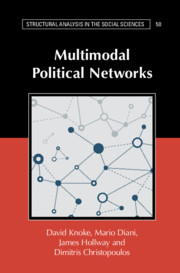Book contents
- Frontmatter
- Contents
- Figures
- Tables
- Preface
- 1 Politics, Communities, and Power
- 2 Multimodal Graphs and Matrices
- 3 Agency, Influence, Power
- 4 Political Communities in a Policy Network
- 5 Individuals in Associations
- 6 Agents and Events in Collective Action Fields
- 7 Nations Trading and Fighting
- 8 Legislative Influence
- 9 The Potential of Multimodal Political Networks
- Appendices
- References
- Index
4 - Political Communities in a Policy Network
Published online by Cambridge University Press: 12 May 2021
- Frontmatter
- Contents
- Figures
- Tables
- Preface
- 1 Politics, Communities, and Power
- 2 Multimodal Graphs and Matrices
- 3 Agency, Influence, Power
- 4 Political Communities in a Policy Network
- 5 Individuals in Associations
- 6 Agents and Events in Collective Action Fields
- 7 Nations Trading and Fighting
- 8 Legislative Influence
- 9 The Potential of Multimodal Political Networks
- Appendices
- References
- Index
Summary
Chapter 4 analyzes public policy networks, especially in relation to policymaking events. We begin by reviewing key concepts in this field – policy communities, policy events, and event public networks – before presenting a restricted 2-mode perspective on policy communities. Our application is to the US labor policy domain, analyzed with concepts and methods introduced in the preceding chapters: core/periphery models and optimal modularity community analysis. We next extend the application to a less-restricted 3-mode network of private-sector organizations’ interests in events, government organizations’ interests in events, and direct communication ties between (but not within) the private and government organizations. A multidimensional scaling analysis of this 3-mode structure reveals how homogenous and relatively tightly structured this policy field is. By preserving complete multimodal network information, the results both support previous research on event publics and yield a more nuanced understanding of the structural contexts within which policy communities attend to their interests.
- Type
- Chapter
- Information
- Multimodal Political Networks , pp. 78 - 92Publisher: Cambridge University PressPrint publication year: 2021



